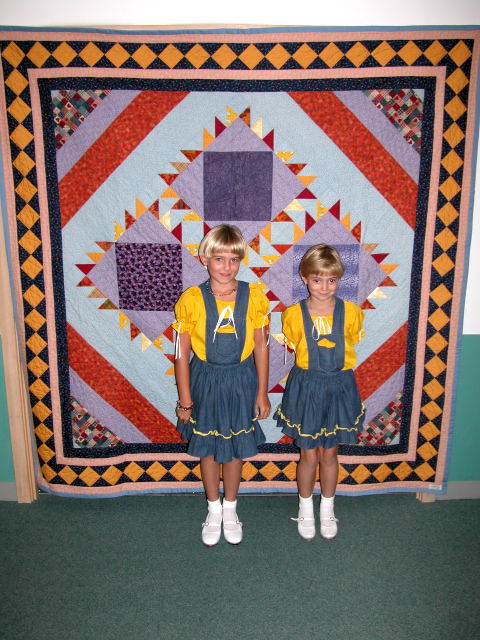“Fire on the Mountain”
by Dr
Sunny Stephens
During the seventeenth and
eighteenth centuries, some of our ancestors came to the “New World” before it was the United States hoping for access to opportunities unavailable to
them in Europe. They were rarely
wealthy immigrants. Affluent Europeans
of the time generally had no reason to leave their homes in Europe. Many English, Irish, and German immigrants
settled in the Appalachian Mountain area, bringing little from their homeland
but the arts they knew. Most notable
were fiddle tunes and folk dances. Out
of necessity, more of the women, regardless of origin, were also quilters.
During those early years
quilt-making, particularly patchwork, evolved from the need to utilize small
scraps of fabric when large yardage was scarce or costly. Some of the original patterns were so
uniquely beautiful that patchwork quilting eventually became a true American
art form.
 At the same time, the English immigrants in Appalachia were dancing the Lincolnshire Clog dance. The Irish were step dancing and hard shoe
dancing to such folk tunes as “Cotton-eyed Joe,” “The Irish Washer Woman,”
“Sailor’s Hornpipe,” and “Shady Grove” brought from Ireland and played on the fiddle. The German immigrants to the area brought a
folk dance called the polka, characterized by fancy footwork and high
kicking. A combination of the various
types of folk dancing eventually produced a brand new hybrid dance peculiar to
the Appalachian area.
At the same time, the English immigrants in Appalachia were dancing the Lincolnshire Clog dance. The Irish were step dancing and hard shoe
dancing to such folk tunes as “Cotton-eyed Joe,” “The Irish Washer Woman,”
“Sailor’s Hornpipe,” and “Shady Grove” brought from Ireland and played on the fiddle. The German immigrants to the area brought a
folk dance called the polka, characterized by fancy footwork and high
kicking. A combination of the various
types of folk dancing eventually produced a brand new hybrid dance peculiar to
the Appalachian area.
Additionally, the Cherokees
were the original inhabitants of Appalachia. The U.S. military under President Andrew Jackson forced the
removal of the Cherokees from their land by way of the “Trail of Tears” in
1836. But the European immigrants,
friendly with the local Native Americans, had already integrated some of the
steps from their ceremonial dances into this new form of Appalachian dancing
referred to as “clogging.” Staccato taps
were added to the shoes of the dancers much later. During the 20th century, Kentucky musicians – most notably Bill Monroe – further
Americanized the traditional Irish fiddle tunes and created another new art
form called “Kentucky Bluegrass.” Today,
traditional clogging is accompanied by Bluegrass music.
Appalachian families who
moved west introduced the new American art forms of patchwork quilting,
clogging, and traditional fiddle tunes to other parts of the country. The family of
Linda Carolan, the director of the “Fire on the Mountain Cloggers,” left Appalachia in the
early 1800’s and settled in Texas under the impresario
system. She is committed to maintaining
the original American art form for future generations. The “Fire on the Mountain Cloggers”
(named for an old time fiddle tune, of course) are based in San Antonio but entertain throughout the United States and in other countries for the sole purpose of
preserving the art form.
The quilt pictured is an
original pattern called “Fire on the Mountain” and honors the “Fire on the
Mountain Cloggers.”
It was designed, machine pieced, and hand quilted by Sunny Stephens,
whose family also left Appalachia and settled in Texas about the same time.
It is a variation of “Delectable Mountains,” one of the oldest patterns documented in the United States. The red,
orange, and gold suggest “fire” on purple mountains. The gold and navy borders are the colors of
the costumes worn by the Cloggers. True to Appalachian tradition, no fabric was
purchased for the quilt. All were scraps
from other projects.
Dr. Stephens, an experienced
quilter, is a retired English professor and the author of numerous books. She is also grandmother of Savanah and Alanna Stephens, two members
on the Fire on the Mountain Junior Team.
The Stephens family is actively involved in performing with and
supporting the Fire on the Mountain Cloggers.
Back
Back to Main Page
 At the same time, the English immigrants in
At the same time, the English immigrants in